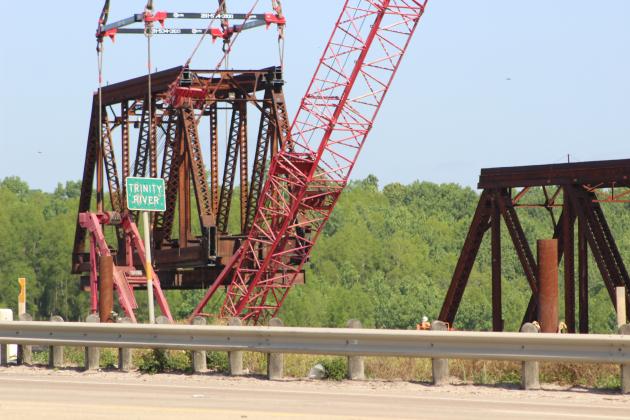Out with the Old
Historic rail crossings replaced
For over a century, trains have crossed the Trinity River at Liberty on the same Truss bridges built in 1904 and 1919. Last Thursday, May 12th, the two sections of the 1919 Swing Bridge were removed. Now, in its place is a new permanent span and an interim shorter jumper span.
Disassembly and removal of the Swing Bridge were accomplished by Roll-Lift USA Inc, a Dayton company responsible for heavy lifting operations throughout North America and South America. Following removal, a new permanent span was secured in place. The entire operation by Roll-Lift was accomplished in exactly 17 hours, according to Robert Jackson, Project Manager.
Russell Marine and Union Pacific completed the interim jumper span connecting to the remaining older and larger truss bridge built in 1904 well before the 7 am contract deadline Friday morning when the first train crossed the Trinity again.
Trains have been crossing the Trinity River at Liberty since 1858, when the Texas and New Orleans Railroad built the first wooden trestle across the Trinity. Disabled briefly during the Civil War, traffic resumed in earnest before 1870. Today, the Union Pacific (UP) reports that this southernmost transcontinental railroad, once the Southern Pacific before UP consolidated its holdings, is one of the busiest sections of rail traffic in the nation connecting the Port of Houston with all points east and west to California.
Anyone who drives along US 90 through Liberty knows that Roll-Lift and Russell Marine equipment has been in place for most of the past year, with the final pieces arriving for staging in the past weeks. Factors far beyond the imagination are involved in the exact timing of when the actual disassembly and reconstruction were to occur. Most importantly, the vital rail line could not be halted for more than 24 hours. Work was scheduled to begin at 7 am Thursday, with the first train crossing the completed new spans at 7 am Friday.
According to Robert Jackson, Roll-Lift Project Manager, the equipment used was a massive LR 11350 crane with a rated lifting power of 1,350 metric tons. Also used were two (2) Self-Propelled Modular Transports (SPMT) controlled in tandem by an operator with a joystick controller. Each SPMT consisted of 10 axles, 20 overall, with a carrying and lifting capacity of 38 metric tons per axle or 760 metric tons. I don’t know about you, but those numbers are as meaningless as the national debt to me.
However, alongside US 90 today sit the two sections of the old 1919 swing bridge. Those sections weigh 538,000 and 535,000 pounds, respectively. Those were not modular units but assembled in place over days and weeks when built. They once set atop a massive circular gear which, controlled by an operator in an attached small room, rotated the conjoined sections 90* for barge and river traffic to pass. The heavier of the two sections is 244 metric tons. It doesn’t take a construction engineer to understand Roll-Lift had this project well under control.
Completion of Phase II, the removal of the 1904 Truss Bridge, will begin at a date TBD in about a month or more, according to Jackson. Effectively, all equipment, on the land and in the river, will move from one bank to the other with the process being repeated. The job will likely be completed in another 24-hour period to minimize downtime on the busy rail line. If you missed seeing the historic construction ballet last week, take a little time to safely watch when the job is finished next month.

